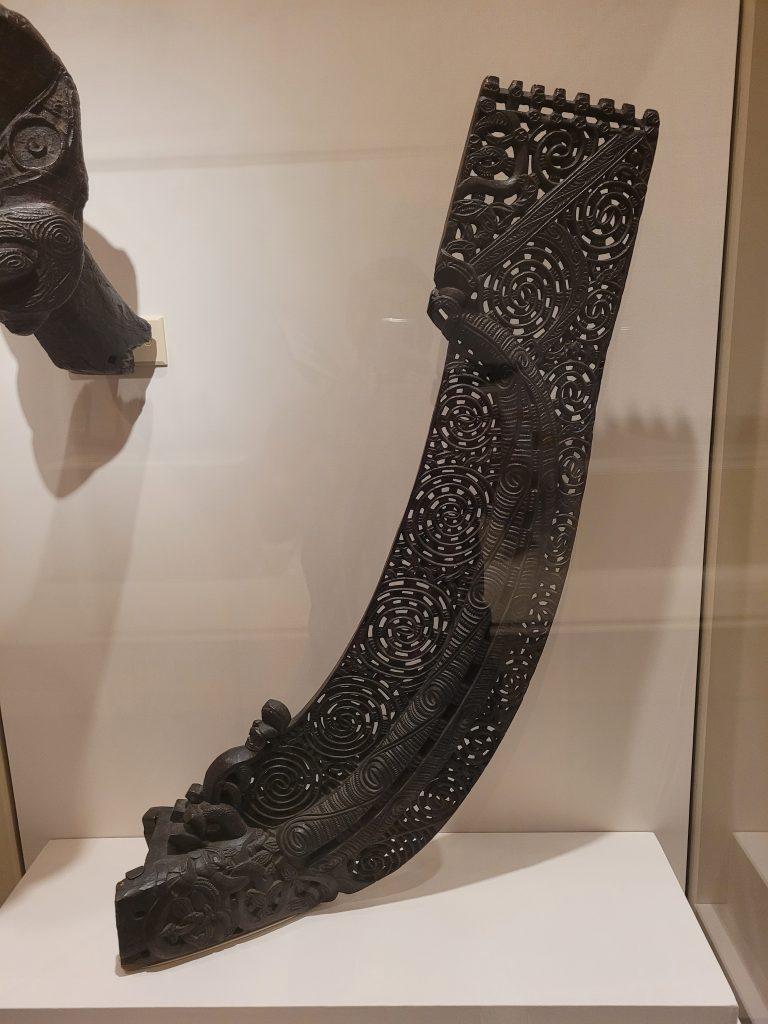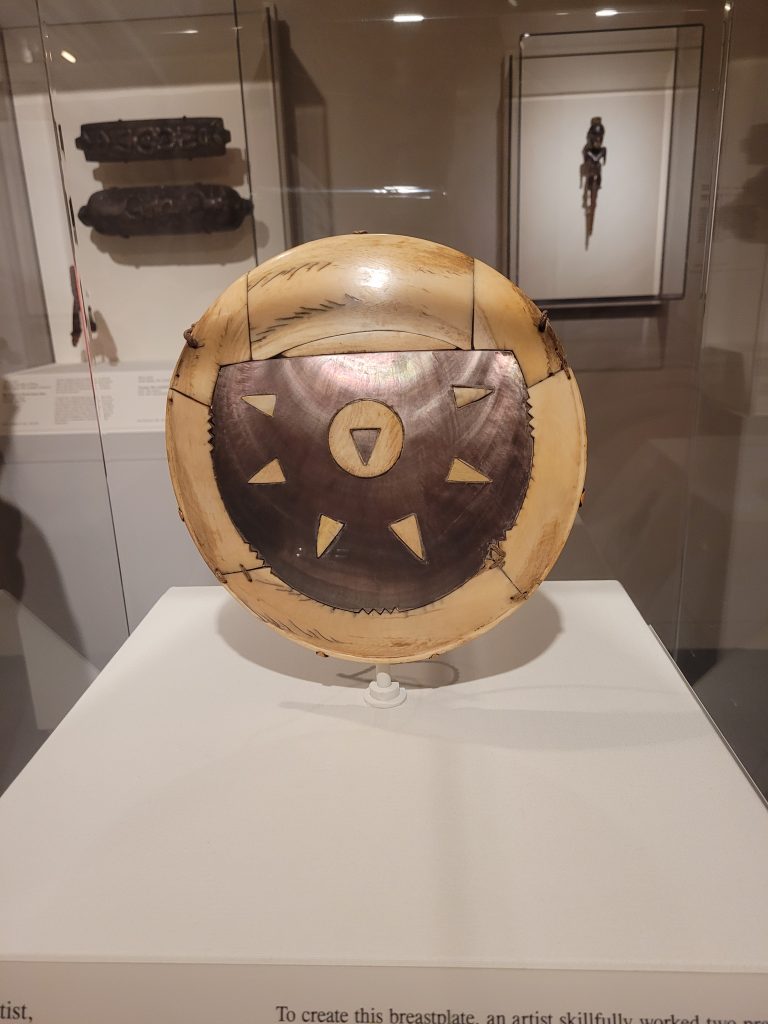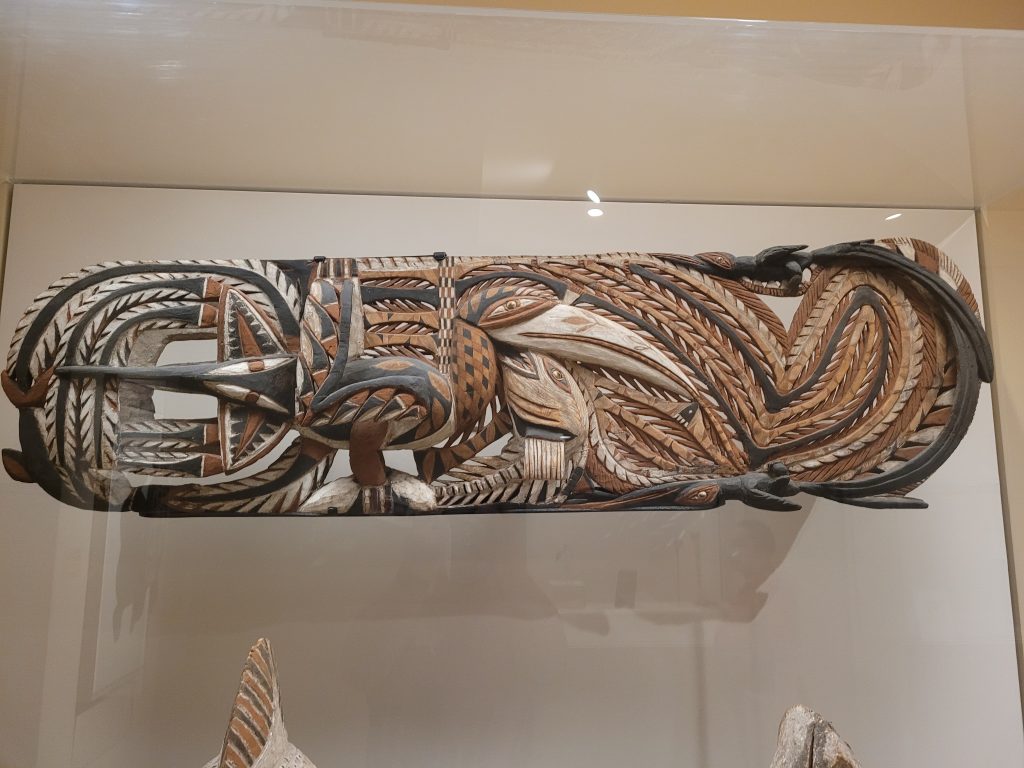For my first exhibit review I went to the St. Louis Art Museum. This renowned institution just reinstalled their Oceanic exhibit and I was instantly drawn in. The exhibit features multiple items spread across all of the Oceanic area, which includes Australia, the microcontinent Zealandia, part of New Guinea, Melanesia, Micronesia, and Polynesia, and shows a wide array of crafted items and styles of construction. Given the exhibition style of the SLAM, there was not an express idea behind their distribution of artifacts or the exhibition. However, I got the impression that there was an idea as the exhibition was placed between the African art exhibit and the Victorian wares, which could cast the concept that the Oceanic exhibit was the bridge between traditional wooden art and modern wares that are ornate and useful.

An example of this thought process could be seen in the exhibition of a war canoe sternpost which has extremely intricate carvings, but is part of something mundane that was essential. Not only is this piece of material essential in a warring party, used for protection and ritualistic ideas, but it was also a treasured piece of art that would be properly cleaned and stored once it was done being used. In addition to this piece was a breastplate crafted from ivory and pearl shell, both extremely valuable and fragile materials.

This piece seemed to serve as the focal point of the exhibit as it was in a small room that was barriered on each side by large carvings that served as guardians for a communal celebration house, implying a sort of protection or celebration for the contents within. This piece would have been worn by an illustrious chief or leader and would be the most illustrious item in one’s mind, but it did not receive this treatment. Many of the items in this area were in dimly lit areas, which the pictures do not properly represent. This item stood beneath a small light and was alone in its case, similar to a distant royal who would have worn it. The breastplate could be sensitive to light, which would explain the dim setting, but in comparison to the collections flanking either side, it seems to be an afterthought, rather than a highlight.
This collection had many illustrious items, but none of them seemed to be the star of the show, nor a representation of a common theme or culture, as New Zealand and especially Māori items were the most prominent amongst the artifacts. There were a few items from New Guinea or Fiji, like the breastplate above, but for the most part, the items were from New Zealand or featured a Māori artist. A majority of these items also featured humans, both female and male, and stylized representations of them, aside from one outstanding piece that seemed more African than Oceanic, which coincides with its placement in the exhibit.

This piece is a memorial artifact that symbolizes a form of the infinite matter that surrounds us all and would be left to deteriorate in the forest after the memorial services. This piece is a stark difference compared to the rest of the exhibit as those items are based around people and practices such as hunting, celebration, and war, whereas this would be used to honor the dead. This is much closer to the African exhibit physically, as it is on the last wall before the transition, but it also features a much more African style, color scheme, and symbolism. This lends itself to the idea that this exhibit serves as a bridge between modern crafts and tools and the ancient art of Africa. This exhibit was reinstalled through the efforts of co-curators Nichole Bridges and Morton D. May, guest curator Philippe Peltier, Jacques Chirac, and Amy Clark. All of the above names besides Amy Clark, who was a research assistant, are curators or co-curators for this exhibit and others, which could mean that this exhibit had the main goal of being educational and comprehensive, as opposed to the meaning I ascertained from it all.
In terms of access and ease of understanding, the exhibit was straightforward and simple in execution. One would simply travel from the Victorian section, or the African section, to the Oceanic section and simply walk straight through it. There are benches in the center of the aisle to allow easier observation or pondering, and had very few elaborate exhibits. The lighting was sufficient but it did not have an inclusive design as the labels were not embossed with Braille, nor were the displays cordoned off for those that might need help to avoid collisions. There was no music or elaborate displays related to the items, as it was literally just a hallway and a small room decorated with white display cases surrounding items encased in glass. The text that was available was slightly small and the sections of text provided ample enough description or context to sate a viewer, if not increase their interest enough to research it more on their own.
Overall, this was an excellent exhibit that allows those with little understanding of Oceania to gain some knowledge and appreciate the craftsmanship illustrated by their people. The exhibit mainly focused on practical items or things related to everyday life, but some of the pieces had memorial qualities or war-related purpose. The gallery was accessible and even provided a place to rest, which was an improvement compared to others. This exhibit is highly recommended, especially since it is now returned after years of being gone.
Sources:
Hathaway, Matthew. “Reinstalled Galleries Present a New View of Oceanic Art at the Saint Louis Art Museum.” Saint Louis Art Museum, May 21, 2021. https://www.slam.org/press/reinstalled-galleries-present-a-new-view-of-oceanic-art-at-the-saint-louis-art-museum/.
St. Louis Art Museum Oceanic Exhibit, in person with the author, June 4, 2022.
I always enjoy seeing SLAM’s motif of “large/colorful/heavy/weird/central object symmetrically framed by rows of cases and architecture.” I feel like every gallery has that big, front-row piece placed obviously at the top of the “hierarchy” of the rest of the exhibit. I love it though – always a breathtaking moment. It’s interesting that the apparent “main event” item of the Oceania exhibit was so underwhelming, since that’s a pattern that SLAM uses all over!